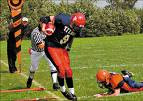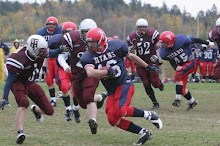One of the thrills of being a football defensive co-ordinator is the excitement of blitzing your opponent, pressuring the quarterback, and forcing a well oiled offensive machine into turn-over's and mistakes.
A carefully planned blitz attack by an aggressive group of football athletes can throw a wrench into the offence and make the playing field a little more even against teams that are superior in talent and strength.
But it can certainly be your downfall as well!
Blitzing is like rolling the dice play after play, it's a gamble that you take, it can be a lot of fun when you get on a roll, sack the quarterback and create a turn-over. But, from time to time, like any gamble, you're going to roll "snake eyes" and pay the price. It won't take too long for a well coached team to take advantage of your blitz attack, expose its vulnerabilities, and move the football. The better teams know that by being patient when under attack and figuring out where and what players are blitzing that they can expose these players and take advantage of the space they vacate in order to blitz. How many times have you watched NFL teams blitz and sack the quarterback in the first quarter and then get ripped apart in the second quarter?
Game over!
Be patient in your blitz. Don't fire the guns play after play and become predictable. Be aggressive, and then back off. Blitz different personnel. Show blitz, get them to audible to another play, then drop into coverage. Keep the offence guessing. As the game moves along, perhaps you'll expose some weakness or flaw in their schemes. Take advantage of it but be patient with it as well. If you find they are having a hard time with it turn up the heat slowly and be cautious of not being placed in a position where you can be exposed and give up a big play.
There will be times that team's will not be able to stop your blitz pressure. But at the same time the better teams will be able to expose this pressure so it's best to be patient with your blitz and be smart with it as well!
Cheers!
A carefully planned blitz attack by an aggressive group of football athletes can throw a wrench into the offence and make the playing field a little more even against teams that are superior in talent and strength.
But it can certainly be your downfall as well!
Blitzing is like rolling the dice play after play, it's a gamble that you take, it can be a lot of fun when you get on a roll, sack the quarterback and create a turn-over. But, from time to time, like any gamble, you're going to roll "snake eyes" and pay the price. It won't take too long for a well coached team to take advantage of your blitz attack, expose its vulnerabilities, and move the football. The better teams know that by being patient when under attack and figuring out where and what players are blitzing that they can expose these players and take advantage of the space they vacate in order to blitz. How many times have you watched NFL teams blitz and sack the quarterback in the first quarter and then get ripped apart in the second quarter?
Game over!
Be patient in your blitz. Don't fire the guns play after play and become predictable. Be aggressive, and then back off. Blitz different personnel. Show blitz, get them to audible to another play, then drop into coverage. Keep the offence guessing. As the game moves along, perhaps you'll expose some weakness or flaw in their schemes. Take advantage of it but be patient with it as well. If you find they are having a hard time with it turn up the heat slowly and be cautious of not being placed in a position where you can be exposed and give up a big play.
There will be times that team's will not be able to stop your blitz pressure. But at the same time the better teams will be able to expose this pressure so it's best to be patient with your blitz and be smart with it as well!
Cheers!














